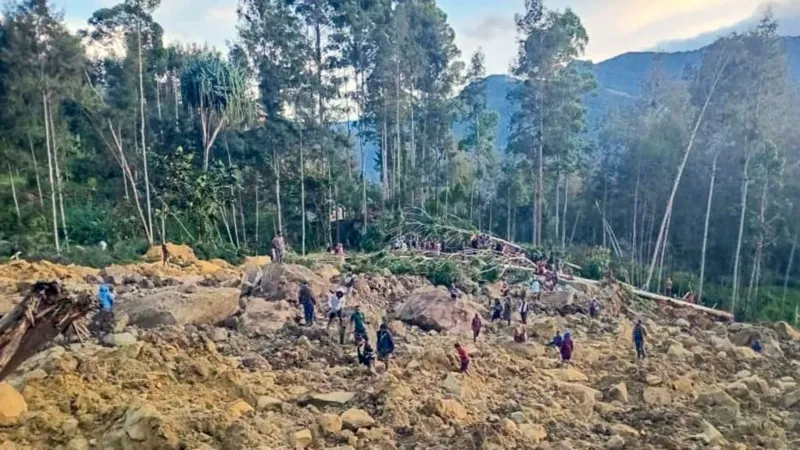Race to rescue villagers trapped after deadly landslide
Emergency services are racing to reach villages hit by a massive landslide in Papua New Guinea's isolated Enga province, where hundreds of people are feared to have died.

A rapid response team made up of medics and military personnel has managed to reach the isolated landslide site, humanitarian agency Care Australia said.
But difficult terrain and damage to main roads is making rescue efforts difficult, it added, with highway access blocked and the area only accessible via helicopter.
The landslide buried hundreds of homes in the highlands of Enga, in the north of the island nation in the south-west Pacific, at around 03:00 local time on Friday (17:00 GMT on Thursday).
It remains unclear how many people are trapped under the rubble.
Care Australia said that 60 homes had been destroyed and "at present, all the members of these households remain unaccounted for".
There are nearly 4,000 people living in the area where the landslide occurred.
But the agency warned that the number affected is "likely to be higher" because of an influx of people escaping conflicts in neighbouring areas.
It added that other villages could also be at risk "if the landslide continues down the mountain".
Amos Akem, an Enga province MP, told the Guardian newspaper that based on reports from the ground, "the landslide buried more than 300 people and 1,182 houses".
He said rescue efforts have been hampered by a blocked road connecting the affected Yambali village and the capital.
There is only one highway into Enga Province. The landslide has created debris up to 8m deep, affecting more than 200 sq km of land "including 150m of the main highway into Enga Province", said Care Australia.
UN official Serhan Aktoprak told AP news agency, that the area affected by the landslide covered the size of three to four football fields.
Some houses in the village were spared by the landslide, Mr Aktoprak said, but "given the scale of the disaster" the death toll might be higher than 100.
The operation to reach those affected has been complicated by fears there could be more landslides.
"The land continues to slide and move, and that makes it dangerous for people to operate," Mr Aktoprak told AFP news agency.
Residents from surrounding areas have described how trees and debris from a collapsed mountainside buried parts of the community, leaving it isolated.
Footage from the scene shows locals pulling bodies from beneath rubble and trees as they traverse the terrain, covered by giant boulders and uprooted trees.
'No houses left'
A resident from a nearby village said that when he arrived at the scene of the landslide, "there was no houses [left]".
Speaking to Australian broadcaster ABC, Dominic Lau said it was all "just flat with soil".
"There was nothing, just rocks and soil... there were no people and there were no houses to see," Mr Lau added.
Enga's governor Peter Ipatas told AFP as many as "six villages" had been affected by the landslide, which he described as an "unprecedented natural disaster".
Enga is more than 600km from the country's capital, Port Moresby.
Papua New Guinea's Red Cross Society earlier said an emergency response team made up of officials from the provincial governor's office, police, defence forces, and local NGOs had been deployed to the site.
Speaking on Friday, Papua New Guinea's Prime Minister James Marape said authorities were responding to the disaster.
He said the government is working with local officials to provide "relief work, recovery of bodies, and reconstruction of infrastructure".
-bbc







